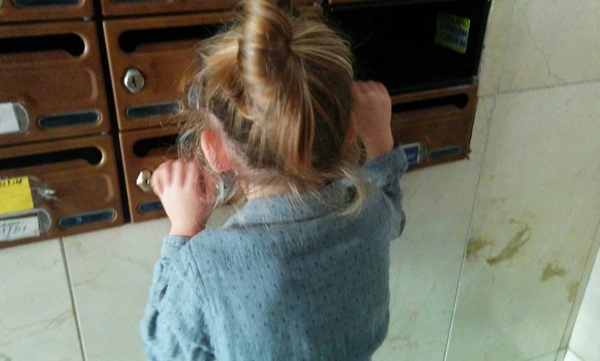Arabic is now the family language my kids hear the least of. They overhear a bit from the grandparents and I still read occasional stories in Arabic which they love. We still use the phrases they have learnt. But Spanish has had a major boost recently in our family, with my four-year old starting school in Spanish and the two-year old getting occasional Spanish babysitting while I myself go off to Spanish lessons.
Since we already have three languages in our daily life, and since I am not a fluent Arabic speaker, it is only a small part of our life. In our current circumstances, there’s neither the exposure nor the need in place to get my kids to speak Arabic well. All the same, I didn’t want to drop it entirely. And so we keep it alive in two very limited contexts: animals and the letter box. This might seem odd. But many multilingual families – whether it be in first world TCK multilingualism or third world nationwide multilingualism – work on the basis of one language for one place/situation/context.
So we use words they already know from our books like The Odd Egg, and from our animal alphabet cards and the conversational Arabic I learnt living in Lebanon to talk about animals we have seen, often on our regular trips to the local zoo. I don’t know if anyone ever got as much use out of their year pass as we have in the past 12 months!
As well, we talk Lebanese Arabic about the letter box. Yes, this is the weird bit. It usually starts with the guessing game “Fi shi ow ma fi shi?” Once we find out what is in the mail, if anything, we discuss that. A lot, a little, a letter, who for, who from, where from? Sometimes the conversation continues as we take the lift up home and open anything interesting. It’s two minutes of Arabic a day, most days. It is what it is. A thread, a connection. And they love it.
Stressing over stress
Recently, my Spanish teacher tried to teach us where to write acute accents in Spanish. The first rule was: Agudas: son las palabras cuya sílaba tónica es la última. Llevan tilde cuando terminan en vocal, n o s. The other rules applied to llanas and esdrújulas. These three categories refer to which syllable the stress falls on.
The problem is I usually don’t know where to put the stress (or tonic accent) in the first place before even asking myself what the final letter is, and if therefore it needs a written accent. So I decided I’d best turn the thing around and learn the stress rules first, since accents are usually used to show exceptions to the stress rules.
The rules of stress are roughly the following:
- In most cases the stress is on the last syllable;
- However, if the last letter of the word is a vowel (very common) or an s or an n, then the stress should be on the penultimate syllable. This gave me a starting point for pronouncing words I don’t know well in Spanish. The next stage is as follows:
- Words following these two rules don’t need accents. Words that don’t follow these rules need accents on their stressed syllables to show that they are exceptions;
- It follows that:
- all words with the stress on the third-to-last or fourth-to-last syllable need an accent on that syllable (eg, el estómago, or the grouped form dándomelo)
- any word ending with a vowel or s or n which doesn’t have the stress on the penultimate syllable needs an accent (el jardín)
- any word ending with the other consonants which doesn’t have the stress on the last syllable needs an accent (fácil)
For me, learning the topic in this order was easier. You don’t need to memorise number 4 since you can deduce it from the rest. If you are already fluent and just need to learn how to write correctly, the other perspective probably works better.
Apart from showing stress, there are a couple of other reasons for using accents in Spanish, but that is enough for me for one night!
